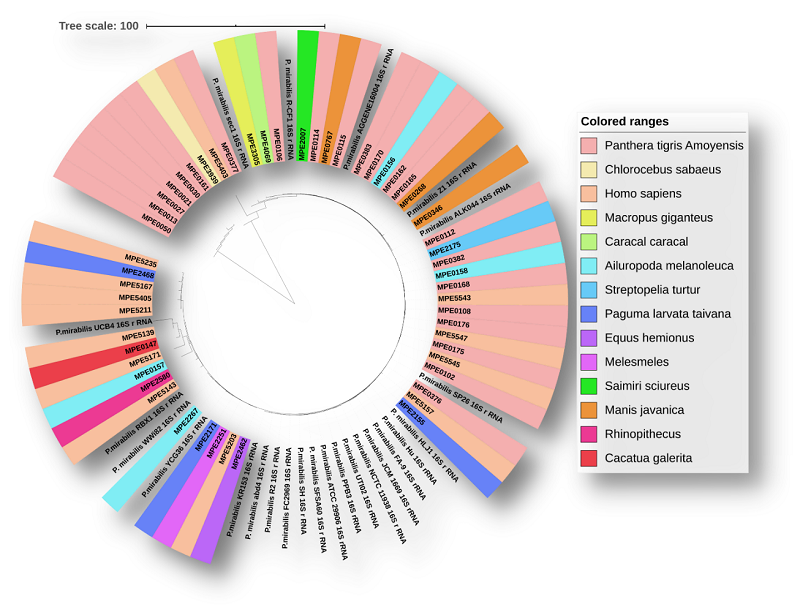Multidrug‐Resistant Proteus mirabilis isolates carrying blaOXA‐1 and blaNDM‐1 from wildlife in China
Date:2021-02-02
Microbial pathogen ecology research Group from the Wildlife Diseases and Immunology Research Center, Institute of zoology, Guangdong Academy of Sciences, conducted research on Proteus mirabilis isolated from wild animals from Shanghai Zoo, hospital, Zhengzhou zoo and illegal trafficking, and found that wild animals carried important multidrug-resistant genes blaOXA-1 and blaNDM-1. On December 2, 2020, the research results were published in integrative zoology (https://onlinelibrary.wiley.com/doi/epdf/10.1111/1749-4877.12510).
Since the widespread use of broad-spectrum antibiotics, proteus has become an important opportunistic pathogen, causing sometimes serious human infection. Proteus mirabilis is the main pathogen of urinary tract infection next to Escherichia coli.
In this study, samples of South China tiger, giant panda, spotted beaver, carambola from the zoo, as well as Malay pangolin, sunflower cockatoo, mountain turtle and other wild animal from the zoo were collected. From the phylogenetic analysis of 16S rRNA, there was no significant difference in evolution among the isolates from different sources.
Drug susceptibility test showed that the drug resistance of isolates from wild animals was significantly stronger than that from hospitals. This phenomenon is obviously contrary to the conventional cognition, but it indicates that there is possibility of antibiotic contamination in the environment inhabited by wild animals to some extent.
Bacterial Genome Wide Analysis showed that Proteus mirabilis isolates did not carry any plasmids, but blaOXA-1 and blaNDM-1 genes were found in the genome. In particular, the two isolates from illegally trafficked Malay pangolin (pangolin malayi) are highly homologous. The resistance gene cluster is composed of a classic intl2 integron, Tn21 and Tn7 transposons. The multidrug resistance gene cluster contains a highly homologous intl2 gene cluster from sunflower cockatoo in Guangzhou and giant panda in Shanghai Zoo, and showed that the integron was partially homologous to the strain of South China tiger from Shanghai Zoo.
At the same time, it was found that the drug-resistant gene cluster and conjugated transfer gene cluster carried by the isolates from Zhengzhou zoo had homology with the isolates from hospital. Among them, the conjugated transfer gene cluster was highly homologous with the GenBank, suggesting that the two gene clusters have the ability to shuttle between different strains. Furthermore, it was also found that the drug-resistant gene cluster and conjugated transfer gene cluster carried by the isolates from Zhengzhou zoo had homology with the isolates from hospital. Among them, the conjugated transfer gene cluster was highly homologous with the GenBank, suggesting that the two gene clusters have the ability to shuttle between different strains.
This study reported firstly that blaOXA-1 and blaNDM-1, important drug resistance genes, were carried by Proteus mirabilis from wild animals in China,and Proteus mirabilis isolates from illegal traffic wildlife and zoo have strong resistance to common first-line drugs. The highly homologous evolution of the strains confirms that they can be transmitted between wild animals, zoo animals and human hosts. Extremely important, it also indicates that the natural environment inhabited by wild animals may be contaminated by antibiotics to some extent。It is of great significance for the public health risk assessment and prevention and control of bacterial resistance.
This project is supported by the project of introducing leading talents of Guangdong Academy of Sciences (2016GDASRC-0205). Kang Qian is the first author and Wang Chengmin is the corresponding author.
Multidrug‐Resistant Proteus mirabilis isolates carrying blaOXA‐1 and blaNDM‐1 from wildlife in China: Increasing public health risk. Integrative zoology. 2020, doi.org/10.1111/1749-4877.12510. (https://onlinelibrary.wiley.com/doi/epdf/10.1111/1749-4877.12510)

Figure 1:Construction of phylogenetic tree based on 16SrRNA from Proteus mirabilis isolates

